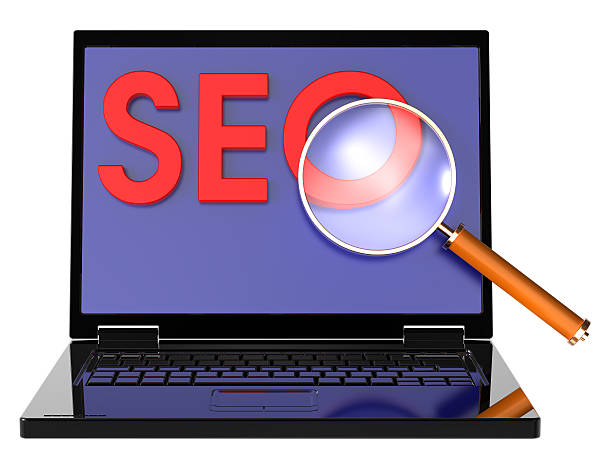An Introduction to SEO and Its Importance in the Digital Age

In today’s fast-paced world, an online presence is vital for every business and individual.
But merely having a website is not enough; you must ensure that your target audience can easily find you.
This is where the concept of #SEO, or Search Engine Optimization, comes in.
#SEO is the process of improving various factors on your website to increase its ranking in search engine results like Google.
The importance of SEO is such that it can be considered the backbone of digital marketing.
A highly-ranked website attracts more organic traffic, and this traffic often leads to increased brand awareness, customer acquisition, and ultimately, more sales.
In fact, many businesses today rely on continuous SEO optimization to compete and survive.
This educational section will help you gain a deeper understanding of what SEO is and why it is vital in today’s digital landscape.
SEO isn’t just about being seen; it’s about being seen by the right people at the right time.
It’s a long-term investment that yields sustainable and significant results.
In this article, we will provide specialized concepts and practical guidance in the field of SEO in an explanatory and comprehensive manner to help you master this area.
A basic understanding of SEO is essential for anyone planning serious online activity.
Does losing customers who have visited your site to make a purchase bother you?
Rasaweb is your specialized solution for a successful online store.
✅ Significant increase in your online sales
✅ Building trust and professional branding with customers⚡ Get free consultation from Rasaweb experts!
On-Page SEO: The Cornerstone of Optimization

On-Page SEO refers to all the actions you take within your website to improve its ranking in search engines.
This includes optimizing content, site structure, and HTML elements.
One of the most important aspects of On-Page SEO is keywords.
Choosing appropriate keywords and strategically using them in page titles, meta descriptions, headings (H1, H2, H3), and main body text plays a significant role in the visibility of your content.
But don’t forget that the main goal is to produce valuable and user-friendly content.
Search engines have become smarter and can easily detect low-quality or keyword-stuffed content.
Therefore, your content should be thought-provoking, in-depth, and responsive to user needs.
Image optimization (using Alt tags), creating appropriate internal links to improve user navigation and distribute SEO value across the site, and ensuring high readability and text quality are all part of On-Page SEO.
Page loading speed is also a crucial factor; today’s users are impatient and will leave slow websites.
Google also prefers faster websites.
In this section, we’ve tried to explain how to optimize these elements in On-Page SEO so that your site has a strong foundation for SEO growth from the very beginning.
Strict adherence to these principles leads to increased organic traffic and improved user experience, both of which benefit your overall site SEO.
Technical SEO: From Infrastructure to Visibility
![]()
Technical SEO refers to optimizing your website’s infrastructure to help search engines crawl and index your content.
This aspect of SEO focuses less on content and more on the technical capabilities of the site, requiring a specialized perspective.
Factors such as site loading speed, mobile-friendliness, URL structure, Robots.txt file, XML sitemap, and the use of structured data (Schema Markup) are all categorized under Technical SEO.
Site speed not only affects user experience but is also one of Google’s ranking factors.
Using CDNs, optimizing images, caching, and compressing code can significantly increase site speed.
Furthermore, with the increasing use of mobile devices to access the internet, website responsiveness is of paramount importance.
Google primarily indexes mobile versions of websites (Mobile-First Indexing).
The Robots.txt file tells search engines which parts of the site to crawl and which not to, while an XML sitemap makes navigation easier for search engines.
This section provides comprehensive guidance to ensure the technical health of your website.
This table shows some of the most common technical SEO issues and their solutions:
| Technical Issue | Description | SEO Solution |
|---|---|---|
| Slow Site Speed | Long page loading times | Compress images and code, use CDN, caching |
| Lack of Mobile Responsiveness | Improper display of the site on mobile devices | Responsive Design |
| Crawl Errors | Search engines cannot find or index certain pages. | Check Google Search Console, fix 404 and 500 errors |
| Broken Links | Links pointing to non-existent pages. | Use link checker tools, update or remove links |
These technical considerations provide a solid foundation for the success of any SEO strategy and often require continuous review and analysis.
Off-Page SEO and the Power of Backlinks

Alongside On-Page and Technical SEO, Off-Page SEO also plays a very important role in your website’s ranking.
Off-Page SEO refers to all activities performed outside your website that help improve its credibility and Domain Authority.
The most important part of Off-Page SEO is backlinks.
Backlinks are links from other websites that point to your site.
Search engines consider backlinks as a “vote of confidence” from other websites; the more high-quality backlinks you have, the higher your site’s credibility will be in the eyes of search engines.
But the important point is the quality of backlinks, not just their quantity.
A backlink from reputable sites relevant to your field of activity is far more valuable than a backlink from irrelevant or spammy sites.
Guidance strategies for building backlinks include creating valuable and shareable content, engaging with bloggers and influencers, having a presence on social media, and participating in relevant forums.
Also, an active presence on social media and sharing your content there can help increase visibility and attract natural backlinks.
Platforms like Twitter, LinkedIn, and Instagram offer great opportunities to increase referral traffic and strengthen Off-Page SEO.
This aspect of SEO requires patience and continuous effort, as building relationships and gaining credibility takes time.
News and events related to your industry can also create news-worthy opportunities to earn valuable backlinks.
A comprehensive SEO strategy will never be complete without sufficient attention to Off-Page SEO.
Are you losing business opportunities because of an outdated website? With Rasaweb, solve the problem of not attracting potential customers through your website forever!
✅ Attract more high-quality leads
✅ Increase brand credibility in the eyes of customers
⚡ Get free corporate website design consultation now!
Content Strategy and Its Role in SEO

Content is king; this phrase holds strong in the world of SEO.
A strong content strategy is the core of any successful SEO campaign.
Producing high-quality, relevant, and up-to-date content not only attracts users but also drives search engines to your site.
Content types can include educational articles, blogging, infographics, videos, podcasts, case studies, and even entertaining content.
It’s important that your content answers user questions, provides in-depth and specialized information, and is continuously updated.
Using secondary keywords and synonyms, internal linking to other relevant content on your site, and optimizing content for Google’s Featured Snippets can significantly help improve your visibility.
Also, creating long and comprehensive content (Long-Form Content) that covers all aspects of a topic is often preferred by search engines, as it indicates depth and topical authority.
This type of content can serve as an explanatory and reference source for users.
Planning a content calendar, conducting keyword research before writing, and analyzing content performance after publication are all vital components of a successful content strategy that directly impact SEO.
Ultimately, content that engages users and provides real value naturally improves your SEO.
Keyword Research: The Backbone of SEO

Keyword research is one of the first and most important steps in any SEO strategy.
Without understanding what words your target audience uses to search for your information, products, or services, you cannot produce content that effectively attracts them.
Keyword research involves identifying the words and phrases users type into search engines and can help discover new opportunities for organic traffic.
Various tools like Google Keyword Planner, Ahrefs, Semrush, and Moz Keyword Explorer help you analyze search volume, competition, and keyword trends.
Beyond core keywords, focusing on Long-Tail Keywords, which are longer and more specific phrases, can be highly beneficial.
These keywords have less competition and often indicate more precise search intent, leading to higher conversion rates.
This section provides an explanation based on the importance of analyzing Search Intent; what users are truly looking for when searching a specific keyword.
Are they looking for educational information? Do they intend to buy? Or do they just want to find entertaining content? Understanding search intent helps you create content that precisely meets user needs and consequently achieves a better SEO ranking.
Continuous and analytical keyword research not only helps you stay informed about trends but also reveals new opportunities to improve your SEO strategy.
Measuring SEO Success and Analytics Tools

To ensure the effectiveness of your SEO strategies, continuous measurement and analysis of performance are essential.
Without data, you cannot know what is working, what needs improvement, or how close you are to your goals.
This section guides you to measure your SEO success using various tools.
Tools like Google Analytics and Google Search Console are two of the most powerful resources for analyzing SEO performance.
Google Analytics provides comprehensive information about your website’s traffic, traffic sources, user behavior on the site, bounce rate, and conversions.
Google Search Console also provides vital insights into how your site appears in search results, the keywords users used to find you, crawl errors, and indexing issues.
This information is essential for a precise and in-depth analysis of your SEO strategies.
You can also use paid third-party tools like Ahrefs and Semrush to check keyword rankings, backlinks, and analyze competitors.
The table below shows some key SEO metrics (KPIs) and their explanations:
| Key Metric (KPI) | Description | Importance in SEO |
|---|---|---|
| Organic Traffic | Number of visitors from natural search results | The primary indicator of SEO strategy success. |
| Keyword Ranking | Your site’s position for target keywords in search results | Indicates visibility for specific phrases. |
| Bounce Rate | Percentage of visitors who leave a page without interaction. | A metric for content quality and user experience; a high rate can harm SEO ranking. |
| Time on Site | Average time users spend on your site. | Indicates content attractiveness and usefulness for SEO. |
This educational content in data analysis enables you to continuously optimize your SEO strategy and achieve more desirable results.
Local SEO and Its Importance for Physical Businesses

Local SEO is a branch of SEO that focuses on optimizing your online presence to attract local customers.
This type of SEO is vital for businesses with physical locations, such as restaurants, stores, clinics, and local services.
The goal of Local SEO is to make your business more prominent in search results for queries with local intent (e.g., “restaurant near me” or “computer repair Tehran”),
One of the most important tools for Local SEO is Google My Business (GMB).
Creating and optimizing your GMB profile, including accurate and up-to-date Name, Address, and Phone number (NAP) information, business hours, images, and customer reviews, is essential for ranking in Google’s Local Pack.
In addition to GMB, collecting positive customer reviews, creating Citations (mentions of business name, address, and phone number in online directories), and optimizing content with local keywords are other important actions in Local SEO.
This strategy guides on how to strengthen your local presence.
Increasingly, “near me” searches are on the rise, indicating the growing importance of Local SEO.
Local news and event content can also help attract traffic and improve Local SEO.
This specialized and explanatory approach is based on the principle that local users generally have a stronger intent to purchase or use services.
Therefore, visibility in local searches means attracting high-quality potential customers.
Is your company’s website as professional and trustworthy as it should be? With specialized corporate website design by Rasaweb, create an online presence that reflects your credibility and attracts more customers.
✅ Build a powerful and professional image for your brand
✅ Convert visitors into real customers
⚡ Get free corporate website design consultation now!
The Future of SEO and Emerging Trends

The world of SEO is constantly changing and evolving.
What works for SEO today might be obsolete tomorrow.
Therefore, staying aware of emerging trends and preparing for them is essential for any SEO strategy.
This section provides an analysis of the future of SEO and factors that will gain more importance in the coming years.
One of the most important trends is Artificial Intelligence (AI) and machine learning, which increasingly influence search engine algorithms.
Algorithms like Google RankBrain and BERT indicate that Google is increasingly understanding search intent and natural language better.
This means your content should be more thought-provoking, natural, conversational, and user-friendly, rather than merely stuffed with keywords.
Voice search is another important trend; with the increasing use of voice assistants like Siri and Google Assistant, optimizing for long, conversational queries is becoming increasingly important.
Focus on User Experience (UX) and Core Web Vitals (Google’s new metrics for measuring user experience quality) is also highly significant.
Websites that provide an excellent user experience not only satisfy users but also get rewarded in terms of SEO.
Entertaining and interactive content can also help increase time on site and reduce bounce rate, both of which are beneficial for SEO.
SEO is moving towards a greater focus on addressing real user needs and providing the best possible experience for them.
This educational and proactive approach helps you always stay one step ahead.
Common SEO Mistakes and How to Avoid Them

In the journey of search engine optimization, committing common SEO mistakes can nullify your efforts and even harm your website’s ranking.
Awareness of these mistakes and the guidance to prevent them is as important as knowing the best practices.
One of the biggest mistakes is keyword stuffing.
Stuffing content with keywords is not only unpleasant for users but can also be identified by Google as a spam technique and lead to site penalties.
Another mistake is Duplicate Content; search engines do not like duplicate content, and this can harm your site’s credibility.
Always produce specialized and unique content.
Lack of mobile optimization, ignoring site speed, absence of high-quality backlinks, and poor site structure are other common mistakes.
Also, not using appropriate title tags and meta descriptions and not regularly updating content can destroy SEO opportunities.
To avoid these mistakes, always focus on quality and user experience.
Write your content for humans, and then optimize it for search engines.
Using SEO tools to monitor performance and identify issues helps you quickly address any SEO problems.
This educational section helps you act intelligently and avoid common SEO pitfalls.
A comprehensive SEO strategy requires avoiding harmful practices and focusing on sustainable and ethical methods that yield real results over time.
Frequently Asked Questions (FAQs)
| Question | Answer |
|---|---|
| What is SEO? | SEO, or Search Engine Optimization, is the process of increasing the quality and quantity of website traffic by improving the site’s ranking in natural (organic) search engine results, such as Google. |
| What are the main types of SEO? | SEO is divided into three main categories: On-Page SEO, Off-Page SEO, and Technical SEO. |
| What does On-Page SEO include? | On-Page SEO includes optimizing elements within the website, such as keywords, Title Tags, Meta Descriptions, content, URL structure, images, and internal links. |
| What is Off-Page SEO? | Off-Page SEO refers to activities outside the website that help improve its ranking, such as Backlink Building, social media marketing, and Brand Mentions. |
| What is Technical SEO? | Technical SEO focuses on optimizing the technical aspects of a website to help search engines crawl and index it better. This includes site speed, mobile-friendliness, site structure, Sitemaps, and the Robots.txt file. |
| What role do Keywords play in SEO? | Keywords are phrases that users enter into search engines. Correct and targeted use of relevant keywords in content and site elements helps search engines understand your page’s topic and display it for relevant searches. |
| What is a Backlink and why is it important? | A backlink, or inbound link, is a link from one website to another. Backlinks act as a “vote of confidence” from other sites for search engines and play a crucial role in a site’s credibility and ranking increase, especially if they are from reputable sites. |
| What impact does quality content have on SEO? | High-quality, relevant, comprehensive, and unique content not only attracts and retains users but also signals to search engines that your page is valuable. This helps improve rankings, reduce bounce rates, and increase user time on site. |
| Why is site loading speed important for SEO? | Site loading speed is an important ranking factor for Google. Faster sites offer a better user experience, have lower bounce rates, and are preferred by search engines. |
| Is SEO a one-time process? | No, SEO is an ongoing and long-term process. Search engine algorithms are constantly changing, competition is increasing, and website content also needs updating. Therefore, SEO requires continuous monitoring, analysis, and optimization. |
And other services of Rasa Web Advertising Agency in the field of advertising
Smart Google Ads: Professional optimization for online growth using marketing automation.
Smart Brand Identity: A professional solution for user engagement focusing on custom programming.
Smart Digital Branding: Designed for businesses seeking digital branding through intelligent data analysis.
Smart Advertising Campaign: A fast and efficient solution for digital branding focusing on attractive UI design.
Smart Sales Automation: An effective tool to increase click-through rates with the help of attractive UI design.
And over a hundred other services in the field of internet advertising, advertising consultation, and organizational solutions
Internet Advertising | Advertising Strategy | Advertorial
Resources
What is SEO?Complete SEO GuideWebsite Optimization for GoogleSEO Principles
? For your business to leap forward in the digital world, Rasaweb Afarin Digital Marketing Agency offers innovative and targeted solutions with expertise in areas such as WordPress website design, SEO, and content marketing.
📍 Tehran, Mirdamad Street, next to Bank Markazi, Kazeroon Jonoubi Alley, Ramin Alley, No. 6




